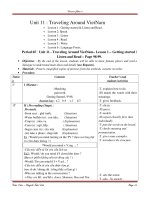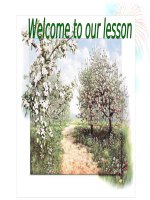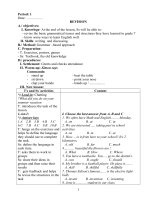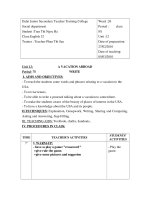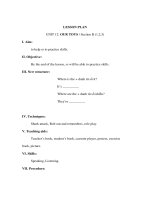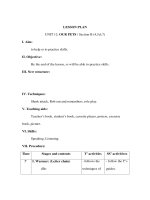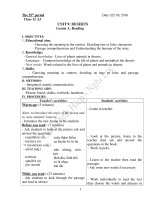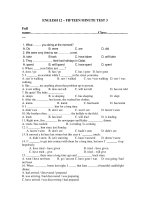leson plan - english 12 ( total of 3 plans)
Bạn đang xem bản rút gọn của tài liệu. Xem và tải ngay bản đầy đủ của tài liệu tại đây (3.49 MB, 115 trang )
The 55
th
period Date: 02/ 01/ 2010
Class 12 A3
UNIT 9: deserts
Lesson A: Reading
I. Objectives:
1. Educational aim:
- Guessing the meaning in the context. Deciding true or false statements
- Passage comprehensions and Understanding the humour of the story.
2. Knowledge:
- General knowledge: Lives of plants animals in deserts.
- Language: Common knowledge of the life of plants and animals in the deserts
- New words: Words related to the lives of plants and animals in deserts.
3. Skills:
- Guessing meaning in context, deciding on true or false and passage
comprehension.
II. Methods:
- Integrated, mainly communicative.
III. Teaching aids:
-Picture, board, chalks, textbook, handouts,…
IV. Procedure:
Teacher s activities’ Students activities’
Warm-up: (5 minutes)
Aims: to introduce the topic of the lesson and
to raise students' interest.
- Introduce the new lesson to the students.
Before you read : (7 minutes)
- Ask students to look at the picture ask and
answer the questions.
- expedition (n)
- mystery (n)
mysterious (adj.)
- aerial (adj.)
- territory
- spinifex (n)
- (to) stretch
cuộc thám hiểm
sự huyền bí, bi ẩn
trên không, trên
trời
lãnh địa, lãnh thổ
cỏ lá nhọn
trải dài
While you read : (23 minutes)
- Ask students to look through the passage
and read in silence
- Listen to teacher.
- Look at the picture, listen to the
teacher then ask and answer the
questions in the book.
- Work in pairs.
- Listen to the teacher then read the
passages
- Ask some new words if necessary
- Work individually to read the text
then choose the words and phrases in
1
- Help students read the passage
- Explain pronunciation and meaning of new
words which appear in the passage
Task 1 : (3 minutes)
A B
1. Royal Geographical
Society of Australia
2. dune
3. hummock
4. crest
5. Australia Aborigine
6. sloping
7. steep
5a. th dõn c
7b. dc ng
4c. nh
1d. Hi a Lý
Hong Gia c
6e. dc thoai thoi
3f. gũ, ng
2g. n cỏt
- Ask students to read through the text once
to find out some new words, guess the main
idea.
- Explain new words (give the Vietnamese
equivalents), guide the sts to get the main
contents of the reading text.
- Ask students to work individually in 3
minutes to do this task.
- Guide students to read through the passage,
and then focus on only the sentences
surrounding the suggested words to do the
task effectively.
- Give students some more words that may be
new/ unfamiliar to them.
- Guide the students to read the word in
chorus and individually.
Task 2: (4 minutes)
- Ask students to read the passage again then
work in pairs to choose the statements are
true or false.
- Walk round the class to give help if
necessary.
- Give suggested words, phrases or useful
suggestions.
- Correct the students work.
T F
1. According to the passage,
there are three great deserts in
Australia.
the passage:
- Share the key with other students:
Keys:
1. Kéo dài, căng ra
2. Có cát,
3. Trắc lợng trên không
4. Hội địa lý hoàng gia Austra
5. Thổ dân Australia
6. Cồn cát, đụn cát
7. độ dốc, dốc thoai thoải
8. Dốc đứng, dốc ngợc
9. Gò, đống
10. Đỉnh (gò/đống)
11. Cỏ lá nhỏ mọc trên xa mạc
2
2. The Simpson Desert is the
largest one in Australia.
3. The desert was named after
Simpson in 1929.
4. Colson and Madigan
travelled across the Simpson
Desert in 1936,
5. There are more dunes in the
western part of the desert.
6. Dry salt lakes are in the
northern part of the desert.
Task 3: (6 minutes)
- Ask students to read the questions carefully.
- Ask students to read through the passage
again.
- Ask the class to do .
- Call some students to give the answers.
- Ask others students to correct.
- Give the true answers
- Questions:
1. Where is the Simpson Desert?
2. When did the first European enter the
desert?
3. How did E. A. Colson and an Australia
Aborigine travel across the desert?
4. What kinds of grass grow in the Simpson
Desert?
After you read : (8 minutes)
- Ask student to read the story.
Ask them for the humour of the story.
Explain.
Home work: (2 minutes)
- Review the reading and prepare the
speaking at home.
- Listen to the teacher then do the task.
- Works in pairs:
Keys:
1. F, 2. F, 3. T,
4. F, 5. F, 6. T.
- Work individually to read the text
then answer the questions:
- Share the key with other students:
Keys:
1. They are Great Victoria Deserts,
Gibbon .…
2. It lies between Lake Eyre in the
south, the .…
3. In 1845.
4. He was the President of the
South .…
5. They took camels across the desert.
6. In the western part, they are short,
mostly .…
7. Two. They are hummock grasses and
spinifex
- Read the story then answer.
- Work in groups
-Listen to the teacher
- Write down the homework to do at home.
The 56
th
period Date: 03/01/ 2010
Class 12 A3
3
UNIT 9: deserts
Lesson B: Speaking
I. Objectives:
1. Educational aim:
- Explaining why some kind of trees and animals can exit in the deserts.
2. Knowledge:
- General knowledge: The lives of trees and animals in the deserts.
- Language: + The way to make the life better in the deserts.
+ The tenses.
- New words: words related to the trees and animals in the deserts.
3. Skills:
- Talking about nature features of the deserts.
- Explaining why some thing should be brought along while going across a desert.
II. Method:
- Integrated, mainly communicative.
III. Teaching aids:
- Board, chalks, textbook, handouts.
IV. Procedure:
Teacher s activities’ Students activities’
Warm-up: (5 minutes)
Banana cactus grass lizard
Camel buffalo date palm
Fox goat eucalyptus
Pre-speaking : (12 minutes)
Task 1
- Guide students how to practise.
- Ask students to work in pairs.
- Explaining some new words.
- Walk around and help them.
- Call students to say.
- Correct their mistakes.
Activity: Find out as many natural
features of a desert as possible.
- Climate: hot, cold, dry
- Rainfall: little rain, much sunshine
- Plants/trees: few (cactus, date palm)
- Animals: few (fox, camel)
- Soil: sandy, dry
- Seasons: summer, winter
Useful language:
- I think, we should …
- In my opinion, …
- I agree with you, …
Kim’s game
- Pairs work.
- Practice answering the topic:
I think banana can’t exit in desert because
it is tropical plant but it is very hot in
desert … ………
I think ….
- Listen to the teacher and do the task.
Ex:
A. I think the climate in desert is very
4
- I can’t agree with you more …
- I don’t think so, you’d better …
- I disagree with you because .…
- It’s not a good idea because …
While-speaking : (15 minutes)
Task 2
- Guide students how to practice.
- Ask students to work in pairs.
- Help the students with new
structures.
- Walk around and help them.
- Call some student to stand up and
report before the class.
- Correct their mistakes.
III. Post-speaking:
Task 3: You are going on an
expedition across a desert with some
of your friends. Discuss and choose
the five most important things you
should bring along with you.
A knife
A box of match
Water
A gun
A car
A mosquito net
A horse
A camel
A cell phone
Food
A blanket
A walkman
- Guide students how to practise.
- Ask students to work in groups
- Call some pairs of student to stand up
and practise.
- Correct their mistakes.
Homework: (3 minutes)
- Ask the students to prepare the
listening at home.
rude. There is very little rain and it is
always very hot….
I think ……
……………………
- Free practices
- The students who are called stand up to
talk to the class about their ideas.
Models: “I think we should bring a blanket
because the climate is very cold at night
”…
- Listen to the teacher.
- Write down the homework to do at home.
The 57
th
period Date: 04/01/ 2010
Class 12 A3
UNIT 9: deserts
Lesson C: speaking
I. Objectives:
1. Educational aim:
5
- Listening, mastering the content of the tape.
- Doing the tasks fluently (true or false statements and the details).
2. Knowledge:
- General knowledge: By the end of the lesson, students will be able to understand
how to make the lives in the deserts better.
- Language: The present simple tense.
- New words: Words related to the topic.
3. Skills: - Listening and deciding on True or False statements.
- Listening for details and gap-filling.
II. Method:
- Integrated, mainly communicative.
III. Teaching aids:
- Tape, cassette player, board, chalks, textbook.
IV. Procedure:
Teacher s activities’ Students activities’
Warm-up: (3minutes)
Students guess 2 items with 3 cues.
1. Cactus
- a kind of plant with hard needles.
- it grows in dry land
- picture
2. Camel
- a kind of animal used to carry things
and people
- it has 2 humps.
- picture
T introduces the desert.
Before-listening: (7 minutes)
Before you listen:
- Ask students to look at the book and
answer the question in the book.
- Let them work in pairs.
- Listen and correct for them.
Answer the questions.
1. What is a desert?
2. How is a desert formed?
3. Can human beings make a desert?
Why/Why not?
Listen and repeat:
frightening speed
Australia
Sahara
firewood
petroleum
Mauritania
Listen and repeat
Guessing game
Before you listen:
- Look at the book.
- Listen to the teacher.
- Ask and answer the question in the book.
- Work in pairs.
- Ss work in pairs to answer the Qs.
6
- Turn on the tape and ask students to
listen
- Let students listen again and repeat.
- Write some words on board and ask
students to read them aloud.
- Correct.
Answer the questions.
1. What is a desert?
2. How is a desert formed?
3. Can human beings make a desert?
Why/Why not?
Listen and repeat:
frightening speed
Australia
Sahara
firewood
petroleum
Mauritania
While-listening: (25 minutes)
Task 1:
Ask students to read the statement at
least once first.
Ask them to guess the answers
Play the tape once then check how
many answers can students find.
Play the tape again.
Check and give remarks.
Call some students to say out their
answers and the evidences they get to
prove their answers.
Task 2: Listen again and fill in the
table.
- Ask them to guess the answers.
Play the tape once then check how
many answers can students find.
Play the tape again.
Check and give remarks.
- Call some students to say out their
answers and the evidences they get to
prove their answers.
- Let students work in pairs.
1. The talk
examines
- What deserts
are
- _________
- Listen and repeat.
- Preactise in pairs
- Read the new words aloud in chorus then
individual.
- Read the statement once to get the main
contents.
Listen to the tape and do the task.
Find evidences to each of the answers.
Represent if being asked.
Keys: 1.T, 2.F, 3.T, 4.F, 5. T.
- Listen to the teacher’s explanation then
correct the answers oneself.
- Read the questions once to get the main
contents.
Listen to the tape and do the task.
Find evidences to each of the answers.
Represent if being asked.
Listen then answer.
Keys:
1. It examines deserts, what are they and
how they are formed
7
2. Desert is - It is _______
place.
- It is also a
______ and
space.
3. The causes of
the growing of
the world’s
deserts
- nature and
_______
4. The way
rabbits contribute
to the growing of
deserts in
Australia
They eat
______, which
makes the land
become desert.
Task 3:
- Ask students to read the question
quickly.
- Guide students the how to do the task.
- let student listen one or twice times.
- Ask students to stand up and speak
their answers.
- Correct.
After-listening: (7 minutes)
- Ask students to discus the guided
question, find the answer then write
about deserts.
- Let them work in groups
- Move around to help if necessary.
- Give remarks or even suggestions.
Homework: (3 minutes)
- Ask students write things to do to have
a healthy and long life, and prepare part
writing at home.
2. It is hot, dry and sandy place, it is a
beautiful land of silence and space. The
sun shines, the wind blow and time and
space seem endless.
3. Natural and human.
4. They contribute by eating every plant
they can find, this makes the land become
deserts.
- Read the questions once to get the main
contents.
Listen to the tape and do the task.
Find evidences to each of the answers.
Represent if being asked.
Listen then answer.
Keys:
1.90%, 2. Smaller plants. 3. Prevent,
4.Spreading
5.Capital, 6.canals
- Listen to the teacher’s explanation then
correct the answers oneself.
- In groups, discuss the guided questions
and write about the deserts to correct
oneself.
-Listen to the teacher and write down
homework to do at home.
The 58
th
period Date: 05/01/ 2010
Class 12 A3
UNIT 9: deserts
Lesson D: Writing
8
I. Objectives:
1. Educational aim:
- Describing main features of a desert.
2. Knowledge:
- General knowledge: Writing about the Sahara deserts.
- Language: +The tenses.
+ Connectors (time expressions)
- New words: Words related to the Sahara desert.
3. Skills:
_ To practise students’ speaking and writing skills.
_ To help students to able to write about the Sahara deserts
II. Method:
- Intergrated, mainly communicative
III. Teaching aids:
- Board, chalks, textbook and notebook.
IV. Procedure:
Teacher s activities’ Students activities’
Warm-up: (3 minutes)
- Presentation
Pre-writing: (10 minutes)
- Ask student to read the request of
task one and translate.
- Explain them how to do the task
- give students the structures:
- guide them some new words.
Pre-teach vocabulary:
- tableland (n)
- oasis (n)
- elevation (n)
- cactus (n)
Pre-teach structures:
- (to) lie in
- (to) extend
- There + be …
- besides
- as a result
T runs through information about
Sahara Desert.
- Correct.
While-writing: (20 minutes)
- Ask student to read the request of the
writing.
- Listen to the teacher.
- Listen to the teacher.
- Try to understand the new words and
phrases in the table.
- Work in groups.
- Ask the teacher about the words or phrases
if can't understand.
- Listen to the teacher.
- discuss and write down.
9
- Explain them how to do the task
- guide them to write.
- Walk around and help them.
- Call one to do on board.
- Correct.
Post-writing: (10 minutes)
- Ask some groups to represent their
work, ask other to give remark.
- Choose some good writing to read in
class and give remark.
Homework: (2 minutes)
- Ask students to rewrite the task at
home and prepare part Language
Focus at home.
- work in groups.
- Compare the result to the other groups.
Ex:
The Sahara Desert, which is the largest one
in the world, lies in Northern Africa –
largely in Morocco, Algeria, Tunisia, Libya,
Egypt, Mauritania, Mali, Niger, and Sudan.
It extends from the Atlantic Ocean eastward
past the Red Sea to Iraq. It is 1,610 km wide
and about 5150 km long from east to west.
The total area is more than 9,065,000
square km. The weather is very hot in
summer and very cold in winter. There are
few oases. Dry climate always has influence
on the atmosphere that moisture is almost
totally absent. As a result, the land is so
arid that some main plants and trees can
exist long in the desert like cactuses, date
palm, and a form of acacia. There are many
kinds of animals like gazelle, antelope, fox,
jackal, and camel.
- Listen to the teacher’s explanations.
- Exchange the writing to other groups to
check and give remarks.
- Represent the task on board if being
asked.
Read the writing to get others’ remarks.
- Do as the teacher asked.
- Listen to the teacher and write down
homework.
The 59
th
period Date: 06/01/ 2010
Class 12 A3
UNIT 9: deserts
Lesson E: Language focus
I. Objectives:
1. Educational aim: - Full and contracted forms of auxiliaries.
10
- So, but, however and therefore.
2. Knowledge:
- General knowledge: Combining the sentences.
- Language: Know how to use so, but, however and therefore.
- New words: Words related to the exercises.
3. Skills:
_ To practise students’ pronunciation and writing skills.
_ To help students to be able pronounce the full forms and the contracted
forms of auxiliaries and introduce to them the use of so, but, however and therefore.
II. Method:
- Intergrated, mainly communicative.
III. Teaching aids:
- Board, tape, cassetteplayer, chalks, textbook and notebook.
IV. Procedure:
Teacher s activities’ Students activities’
1. Warm up: ( 3 minutes)
- Introduce the lesson to the students.
I. Pronunciation: ( 15 minutes)
Read the following phrases.
Full Contracte
d
Full Contracted
I am
you are
he is
she is
it is
we are
they are
I’m
you’re
he’s
she’s
it’s
we’re
they’ve
I shall/will
you will
he will
she will
it will
we shall/will
they will
I’ll
you’ll
he’ll
she’ll
it’ll
we’ll
they’ll
_ play the tape and asks students to listen to
the sounds listed in their books.
_ asks students to listen to the tape then
repeat the words in chorus.
_ asks students to repeat the words
individually.
_ correct their pronunciation if necessary.
_ asks students to read the sentences
suggested individually.
_ can read the sentences first and notice the
sounds in words.
_ asks some students to read the sentences
aloud.
_ asks others to give comments then correct
their pronunciation if necessary.
- Listen to the teacher.
Get the teacher’s explanation.
_ Listen to the sounds listed in their
books.
_ Listen to the tape then repeat the words
in chorus.
_ Some individuals repeat the words.
_ Listen to the teacher’s correction.
_ Read the sentences suggested
individually.
_ Listen to the teacher’s explanation.
_ work in pairs. Do the exercise given in
the textbooks.
_ Discuss the answers with their friends
then correct the mistakes themselves.
11
Practise reading these sentences.
I think I’ll buy a motorbike.
You’ll notice that there’s a girl coming.
It’ll be much better if you could do it.
We’ll have to talk to her.
She’s feeling much better now.
They’re students.
He’ll be 17 next month.
II. Grammar: ( 25 minutes)
1. Presentation:
Connectives SO, THEREFORE, BUT AND“
HOWEVER”
- So: vì vaäy, vì theá (conjunction)
ex: I felt sleepy, so I went to bed.
- Therefore: vì vaäy, vì theá (adv)
ex: Hoa failed her math test. Therefore, she
has to do the test again.
- But: nhöng
ex: He is poor but he is honest.
- However: tuy nhieân (adv)
ex: Mary is very tired. However, she has to
finish her homework before she goes to bed.
Exercise1:
- Guide students how to do
- Do the first as an example.
- Ask students to the exercise.
- Call the to on board.
- go round to help students if necessary
- Explain and correct.
1. I didn’t have an umbrella so I got wet.
2. I didn’t have an umbrella but I didn’t get
wet because I was wearing a raincoat.
3. The water was cold so I didn’t go
swimming.
4. The water was cold but I went swimming
anyway.
Exercise 2:
_ explains the example carefully.
_ asks students to work in pairs to do the
exercise suggested.
_ asks students to discuss the answers with
their friends.
_ asks some of the students to do the
_ Some of the students to do the exercise
orally.
_ Other students give comments.
_ Take notes of the suggested answers.
Keys:
1. So 5. So
2. But 6. But
3. So 7. But
4. But 8. So
_ Notice the teacher’s explanation.
_ Work in pairs. Do the exercise given in
the textbooks.
_ Discuss the answers with their friends
then correct the mistakes themselves.
_ Some of the students to do the exercise
orally.
_ Other students give comments.
12
exercise orally.
_ asks others to give comments.
_ gives the suggested answers if necessary.
1. Dan didn’t study for the exam,
however/but Lan did.
2. You could fly via Vienna; but/however it
isn’t the only way.
3. They have lived next door to us for years,
yet/however we hardly ever see them.
4. My friend and I were tired, so/however
we went home early.
Exercise 3:
_ explains the example carefully.
_ asks students to work in pairs to do the
exercise suggested.
_ asks students to discuss the answers with
their friends.
_ asks some of the students to do the
exercise orally.
_ asks others to give comments.
_ gives the suggested answers if necessary.
1. He worked hard, so he could earn much
money.
2. The shrimp was only 2 dollars a kilo this
week, so I bought three kilos.
4. She is still not good at Maths. Therefore
she cannot be the best student in her class.
5. OK, you can take Chemistry as your
major. However you should remember that
it is not easy to learn Chemistry.
4. Homework: (2 minutes)
- Ask students to revise the strong form and
weak form of auxiliaries, the use of
connections, redo all the exercises and
prepare unit 10 at home.
_ Take notes of the suggested answers.
Keys:
1. But 5. But
2. However 6.However
3. Yet 7. However
4. So 8. But
_ Listen to the teacher’s explanation.
_ work in pairs. Do the exercise given in
the textbooks.
_ Discuss the answers with their friends
then correct the mistakes themselves.
_ Some of the students to do the exercise
orally.
_ Other students give comments.
_ Take notes of the suggested answers.
Keys:
1. Therefore, 2. So, 3.So,
4. Therefore, 5. However,
6. Therefore, 7. So,
8. However.
- Listen to the teacher and write down
homework to do at home
The 60
th
period Date: 07/01/ 2010
Class 12 A3
UNIT 10: endanger species
Lesson A: Reading
13
I. Objectives:
1. Educational aim:
- Students read and guess the meaning of words in contexts.
- They read and answer questions about the texts.
- They practice scanning for specific information in the texts.
- Finding supporting evidence.
2. Knowledge:
- General knowledge: Ss know some endangered species are plant and animal
species
- Language: Common knowledge of environment,…
- New words: Words related to the topic (endangered animals, plants )
3. Skills:
- Guessing meaning in context, scanning for specific information and passage
comprehension.
II. Method:
- Integrated, mainly communicative.
III. Teaching aids:
-Picture, board, chalks, textbook, handouts,…
IV. Procedure:
Teacher s activities’ Students activities’
Warm-up: (5 minutes)
Aims: to introduce the topic of the lesson
and to raise students' interest.
- T hang out some pictures in and asks Ss to
answer the questions.
1. what do you see in the pictures?
2. Which of them are in danger of becoming
extinct?
Before you read : (7 minutes)
Pre-teach vocabulary:
- extinction (n)
- extinct (a)
- destruction (n)
- exploitation (n)
- vulnerable (a)
- (to) enact
Sự tuyệt chủng
Sự phá hoại
Sự khai thác
Có thể bò làm hại
ban hành
- Ask students (to work in pairs) to open
their books, look at the pictures, and do the
tasks that follow.
- work in pair to answer the questions
1.tortoise, rhinoceros, monkey, elephant,
leopard, parrot
2.elephant,leopard, rhinoceros are in
danger
necessary
14
+ Which of the animals and insects below
can be found in Vietnam?
+Which of them are in danger of becoming
extinct?
- Ask them to work in 3 minutes,
- Teacher moves round to help if necessary.
- Ask some pairs to report .
- Give some remark if necessary
Pre-teaching vocabulary:
To edanger: (v) g©y nguy hiÓm
Destruction(n) sù ph¸ ho¹i, nguyªn nh©n
g©y ra c¸i chÕt
Commercial(adj):(thuéc )bu«n b¸n
Drainage(n): sù rót níc,hÖ thèng cèng r·nh
Deforestation, urbanization (sù thµnh thÞ
ho¸
While you read : (23 minutes)
- Ask students to look through the passage
and read in silence
- Help students read the passage
- Explain pronunciation and meaning of new
words which appear in the passage
Task 1 : (3 minutes)
- Ask students to read through the text once
to find out some new words, guess the main
idea.
- Explain new words (give the Vietnamese
equivalents),.
- Ask students to work individually in 5
minutes to do this task.
- Guide students to read through the
passage, and then focus on only the
sentences surrounding the suggested words
to do the task effectively.
- Give students some more words that may
be new/ unfamiliar to them.
- Guide the students to read the word in
chorus and individually.
-Give correct answers
A B
1. extinction a. the existence of a large number
of different kinds of animals and
plants which make a balanced
environment
+Tortoise, rhinoceros, elephant,
monkey, mosquito.
+Rhinoceros, leopard, elephant
- Write down the meaning of some new
words
- Read through the text find the new
words, try to guess the meanings of
those words in contexts:
- Work individually to read the text and
do task 1
1.C
2.D
3.A
4.B
- Listen to the teacher
- Write down the correct answers
15
2. habitat b. the act of preventing something
from being lost, wasted, damaged
or destroyed
3. biodiversity c. a situation in which a plant, an
animal, a way of life, etc. stops
existing
4. conservation d. the natural environment in which
a plant or animal lives
Task 2: (4 minutes)
- Ask students to read the passage again and
choose A,B,C,D to complete the following
sentences about the reading passage
- Ask them to work individually to do the
task and give the evidence to prove the keys.
- Move round to make sure that all students
are working and to help them if necessary.
- Ask some students to report and give
feedback.
1. The number of species around the globe
threatened with extinction is over ______.
2. Which of the following is NOT
mentioned as a primary cause of species
extinction?
3. The Red List is a special book that
provides names of _______ animals.
4. The development of wildlife habitat
reserves helps ______.
5. The best tile for the passage is ______.
D. Endangered Species Extinction: Causes
and Conservation Measures
Task 3: (6 minutes)
- Ask students to read the passage again
then work in pairs to find evidence in the
passage to support these statements
- Walk round the class to give help if
necessary.
- Give suggested words, phrases or useful
suggestions.
- Correct the students’ work.
After you read : (8 minutes)
- Ask students to work in group to scan the
text again.
- Read through the text find the new
words,
- Work in pair to answer the questions
1.D 15,000
2.B natural selection
3. A. vulnerable and endangered
4. A. save a large number of
endangered species
5. D. Endangered Species Extinction:
Causes and Conservation Measures
- Read through the text find the new
words,
- Work in pair to give evidence in the
passage to support these statements.
1. The first sentence of the second
passage.
2. The third passage.
3. The fourth.
- Work in group to summarise the
reading passage.
16
- Ask them to work in small groups of three
or four to summarise the reading passage by
writing one sentence for each paragraph.
- Encourage them to summarise the reading
passage.
- Ask one or two pairs to report.
Home work: (2 minutes)
- Ask Ss to do exercises at page 65-68 in
the students’ workbook.
1.Over 24 thousand plant and animal
species all over the world are classified
as endangered.
2.The main causes of extinction or
endangerment are habitant
destruction ,commercial exploitation
and population.
3.Biodiversity is important for humans
as it provides food ,clean air, water,
fertile soil and other products.
4.Different efforts have been made to
confer endangered species.
5.The task of conservation should be
shared by international organization,
governmental agencies ,industry and
individuals.
- Do homework
The 61
st
period Date: 08/01/ 2010
Class 12 A3
UNIT 10: endanger species
Lesson B: Speaking
I. Objectives:
1. Educational aim:
- Students work in pairs to ask and answer some questions about endangered
animals
- Students talk about the information of some endangered animals
2. Knowledge:
- General knowledge: endangered animals
- Language: + The way to make suggestions or predictions.
+ The tenses.
- New words: words related to endangered species.
3. Skills:
- Talking about the information of some endangered animals
II. Method:
- Integrated, mainly communicative.
III. Teaching aids:
17
- picture, board, chalks, textbook, handouts.
IV. Procedure:
Teacher s activities’ Students activities’
Warm-up: (5 minutes)
Hang out the pictures of 4 animals and
ask Ss to give the name of them
h
I. Pre-speaking:
Activity: Answer the question:
- Where do these animals live?
(Forests, seas, swamps, deserts)
Useful language: (structure)
- Habitat: Where do pandas/tigers live?
- Population: What is the population of
pandas/ rhino in the world?
- Weight/ Height: What is the weight/
height of ?…
- Food: What is their main food?
- Life span: How long do they live?
- Reasons for decline: Why do they
decline in the number?
While-speaking (25 minutes)
Task 1:
Ask and answer the following the
questions.
- Ask students to work in pairs to
discus the four questions and find the
answers.
- Move round to make sure that all
students are working and to help them
if necessary.
- Ask some students to report and give
- Look at the pictures and give the name of
4 animals
1.It is a tiger
2.It is a rhino
3.It is a panda
4.It is an elephant
- Work in pairs to discus the three questions
and find the answers.
1. Panda ,rhino, tiger, elephant.
2.We can find these animals in the forests
in Asia, Africa, etc
3.Rhino can be used for medicine
4. All of them are in danger.
- Listen to the teacher
- work in pair to do task 2
A: where do giant pandas live?
B: They live in bamboo forests in the
mountain in central and western China
A: What is the population of pandas in the
world?
B: Only about 600.
A: How are they?
B: about 1.2 to 1.5m
A How much do they weigh?
18
feedback.
- Correct the students’ work and give
remark.
Task 2
Ask and answer questions about 4
endangered animals.
- Ask Ss to read the information about
the gait panda, tiger, rhino and
elephant.
- Explain how to do task 2
- Walk round from group to group to
give help if necessary.
- Encourage students to speak out what
they think even a phrase or a singular
word.
_T check and give feedback.
Task 3:
Take turns to give an oral report on the
animals mentioned in task 2
-T ask Ss to work in group to do task 2.
- Walk round from group to group to
give help if necessary.
- Encourage students to speak out what
they think .
Post speaking(10)–
- Ask students to work individually to
summarize what they’ve learnt in unit
10.
- Move round to check the activities
and to make sure that students are
working effectively.
- Ask one or two students to report in
front of the whole class.
- Check and give remarks.
Homework: (3 minutes)
Name some measures we’ve made to
protect the endanger animals
B: About 75 kg to 160 kg
A: what do they eat
B: Bamboo
A: Why are they in danger?
B: People destroy their habitat and hurt
them for trade.
- Work in group to give an oral report.
Group 1: Giant pandas live in bamboo
forests in the mountain in Western China
.only about 600 pandas are living there.
They attain a height of 1.2m to 1.5m and
weigh from 75kg to 160 kg they are in
danger because people destroy their habitat
and hurt them for trade.
Group 2: Rhino
Group 3:tiger
Group 4 elephant
-Students work individually to summarize
what they’ve learnt in unit 10.
- Do homework at home
The 62
nd
period Date: 10/01/ 2010
Class 12 A3
19
UNIT 10: endanger species
Lesson C: Listening
I. Objectives:
1. Educational aim:
-Students know the life of gorillas
2. Knowledge:
- General knowledge: extensive listening: Multiple-choice questions.
Gap filling
- Language: modal verbs
- New words: Words related to the topic.
3. Skills: - Listening and deciding on True or False statements.
- Listening comprehension
II. Method:
- Integrated, mainly communicative.
III. Teaching aids:
- Tape, board, chalks, textbook.
IV. Procedure:
Teacher s activities’ Students activities’
Warm-up: (5 minutes)
- Rearrange the letters to make a
meaningful word
GOLLARI
Pre-listening: (7 minutes)
- Ask students to work in pairs to
discuss and choose the best answer
A,B,C
- Guide the students to answer if
necessary.
- Give further information.
- Explain the words that will appear in
the listening text.
- Ask students to read in chorus then
individually.
Discuss and choose the best answer
A, B or C
1. You can find gorillas in ________.
2. The male gorilla may attain a height
of ____m and a weight of about 180
kg.
3. The life span of a gorilla in the wild
- Listen to the teacher.
- Work in pairs to Rearrange the letters to
make a meaningful work.
GORILIA
- Work in pairs to discuss and give correct
answers
- Listen and repeat:
Gorilla
Sociable
Sub-adult
Nest
Bared teeth
Silverback
Civil war
Forest rangers
C. Africa
B. 1.7
C. 50
20
is about _______ years.
Listen and repeat:
Gorilla
Bared teeth
Sociable
Silverback
Sub-adult
Civil war
Nest
Forest rangers
While-listening: (20 minutes)
Task 1: Listen to the passage and
choose the best answer.
- Ask students to read the statement
at least once first.
- Ask them to guess the answers
- Play the tape once then check how
many answers students can find.
- Play the tape again.
- Check and give remarks.
- Call some sts to say out their
answers and the evidences they get
to prove their answers.
1. Which of the following can be a
group leader?
2. With whom do baby gorillas sleep at
night?
3. Why do hunters kill mountain
gorillas?
4. Which of the following statements
is NOT true?
5. What can be learned from the
passage?
Task 2
- Ask them to guess the answers.
- Play the tape once then check how
many answers can sts find.
- Play the tape again.
- Check and give remarks.
- Call some students to say out their
answers and the evidences they get to
prove their answers
General (1) peaceful, gentle,
-Read the statement once to get the main
contents.
- Listen to the tape and do the task.
- Find evidences to each of the answers.
- Represent if being asked.
Keys:
1. A. The biggest and strongest adult male
gorilla.
2. B. Their mothers.
3. B. For their nests.
4. D. A gorilla sometimes eats worms.
5. C. Mountain gorillas eat mainly plants.
- Listen to the teacher’s explanation then
correct the answers oneself.
- Read the questions once to get the main
contents.
- Listen to the tape and do the task.
- Find evidences to each of the answers.
- Represent if being asked.
21
features sociable, and (2) plant-
eating
Group
members
The silverback, one or
two sub-adult males, (3) a
few females and their
young
Food (4) a variety of plants and
a few kinds of insects
Place for
sleeping
Nest (5) in trees or (6) in
grasses on the ground
Causes of
being
endangered
(7) civil war, hunters
killing them for food, (8)
forests being cut down
for farmland
After-listening: (10 minutes)
- In group, ask students to summarise
the main ideas of the passage, using
the information and the answers in task
1 and 2.
- Move around to help if necessary.
- Give remarks or even suggestions.
Summarise the main ideas of the
passage, using the questions:
1. Do gorillas live in groups?
2. What are the group members?
3. Where do gorillas sleep?
4. What kind of food do they eat?
5. What are the causes of being
endangered?
Homework: (3 minutes)
- in not more than 80 words write
about the life of a gorilla
Keys:
1.peaceful
2.plant – eating
3.a few females and their young
4.plants and a few insects
5.in trees
6.in grasses
7.civil war
8.forests being cut down
- Listen to the teacher’s explanation then
correct the answers oneself
- Listen to the teacher’s guide to correct
oneself.
-Work in group to summarise the main
ideas of the passage
-Listen to the teacher and write down
homework
The 63
rd
period Date: 11/01/ 2010
Class 12 A3
UNIT 10: endanger species
Lesson D: Writing
I. Objectives:
1. Educational aim:
- Writing a report.
2. Knowledge:
22
- General knowledge: Writing about measures to protect endangered species and
possible results
- Language: + The tenses.
+ Connectors
- New words: Words related to endangered species
3. Skills:
- Writing a report.
II. Method:
- Intergrated, mainly communicative
III. Teaching aids:
- A picture, board, chalks, textbook.
IV. Procedure:
Teacher s activities’ Students activities’
Warm-up: (5 minutes)
Fill in the chart with some information n
about endangered species’ problems.
Endangere
d species
causes Measures
to save
them
+tiger Habitat
destruction
Provide
enough
wildlife
habitat
reserves
Pre-writing: (10 minutes)
- Explain as clearly as possible the way to
write a passage
+topic sentence
+supporting idea
+supporting idea
+Concluding sentence
+connectors: first, second, third
Suggested tenses : Simple present
While-writing: (18 minutes)
Task 1. Work in pairs. Suggest possible
measures that should be taken to solve the
following problems.
- Ask students to look at Task 1.
In pairs, ask students to ask and answer the
questions.
• People do not know much about the need
- Do as required.
- Exchange the ideas with others.
- Listen to the teacher.
- Get the task.
- Work in pairs to do the task.
- Listen to the teacher to correct
oneself.
- Work in groups to do the task.
- Listen to the teacher.
- Get the task.
- Work in pairs to do the task.
- Listen to the teacher to correct
oneself.
Work in groups to do the task
1. We should have different activities to
23
to protect rare and endangered animals.
• Projects to save endangered animals do
not have sufficient funds.
• The habitats for endangered animals are
being seriously damaged and polluted.
• People who live in or near endangered
animals' habitats have poor living
conditions and rely mostly on wildlife
products for their livelihood.
• Some countries do not have laws to
protect endangered animals.
• People keep buying fashionable wildlife
products.
• There are not enough wildlife habitat
reserves.
Example:
People do not know much about the need to
protect rare and endangered animals. We
should organize different activities to raise
people's awareness of the need to protect
these animals.
Task 2
- Explain the requirements: Writing a
paragraph
- Ask students to work in groups to write
paragraph.
- Walk round to give help if necessary.
Post-writing: (10 minutes)
- Ask some groups to represent their work,
ask other to give remark.
- Choose some good writing to read in
class and give remark.
- Work in pairs. Share the results with
your friends next to you.
Example: Many measures should be taken to
raise people’s awareness of the need to
protect these animals.
2. Governments should raise sufficient
funds for projects to save endangered
animals.
3. Humans must keep water, air, and
land clean to preserve natural habitats
for wild animals.
4.Goverments should have a good
policy to improve the life of people who
live in or near endangered animals’
habitats
- Compare the result to the other
groups.
- Listen to the teacher’s explanations.
- Exchange the writing to other
groups to check and give remarks.
- Represent the task on board if being
asked.
- Read the writing to get others’
remarks.
- Do as the teacher asked.
- SS compare the result to the other
groups.
- Listen to the teacher’s explanations.
- Exchange the writing to other groups
to check and give remarks.
24
protect endangered animals.
Firstly, funds should be raised for the projects to
save these animals.
Secondly, The habitats for endangered animals
mustn’t be damaged and polluted.
Thirdly, people living in or near endangered
animals’ habitats should be resettled into other
regions and helped with means to earn their living
instead of hunting or fishing.
Fourthly, the making of products from wildlife
should be prohibited.
Lastly, more habitat reserves for wildlife should
be established.
Homework: (2 minutes)
- Ask students to rewrite the task at home
and prepare part Language Focus at home.
- Listen to the teacher’s explanations.
- Exchange the writing to other groups
to check and give remarks.
- Listen to the teacher and write down
homework.
The 64
th
period Date: 15/01/ 2010
Class 12 A3
UNIT 10: endanger species
Lesson E: Language focus
I. Objectives:
1. Educational aim:
- Pronunciation.
- Rhythm
2. Knowledge:
- General knowledge: modal verbs: may, might, mustn’t,
- Language: may, might, must, mustn’t
- New words: Words related to the exercises
3. Skills:
- Writing sentences with adverbial clauses of concession.
II. Method:
- Intergrated, mainly communicative.
III. Teaching aids:
- Board, chalks, textbook and notebook.
IV. Procedure:
Teacher s activities’ Students activities’
* Practise reading the following sentences,
paying attention to the stressed syllables.
1. Tell me the time.
2. Show me the way.
- Get the teacher’s explanation.
1.Tell me the time.
25
